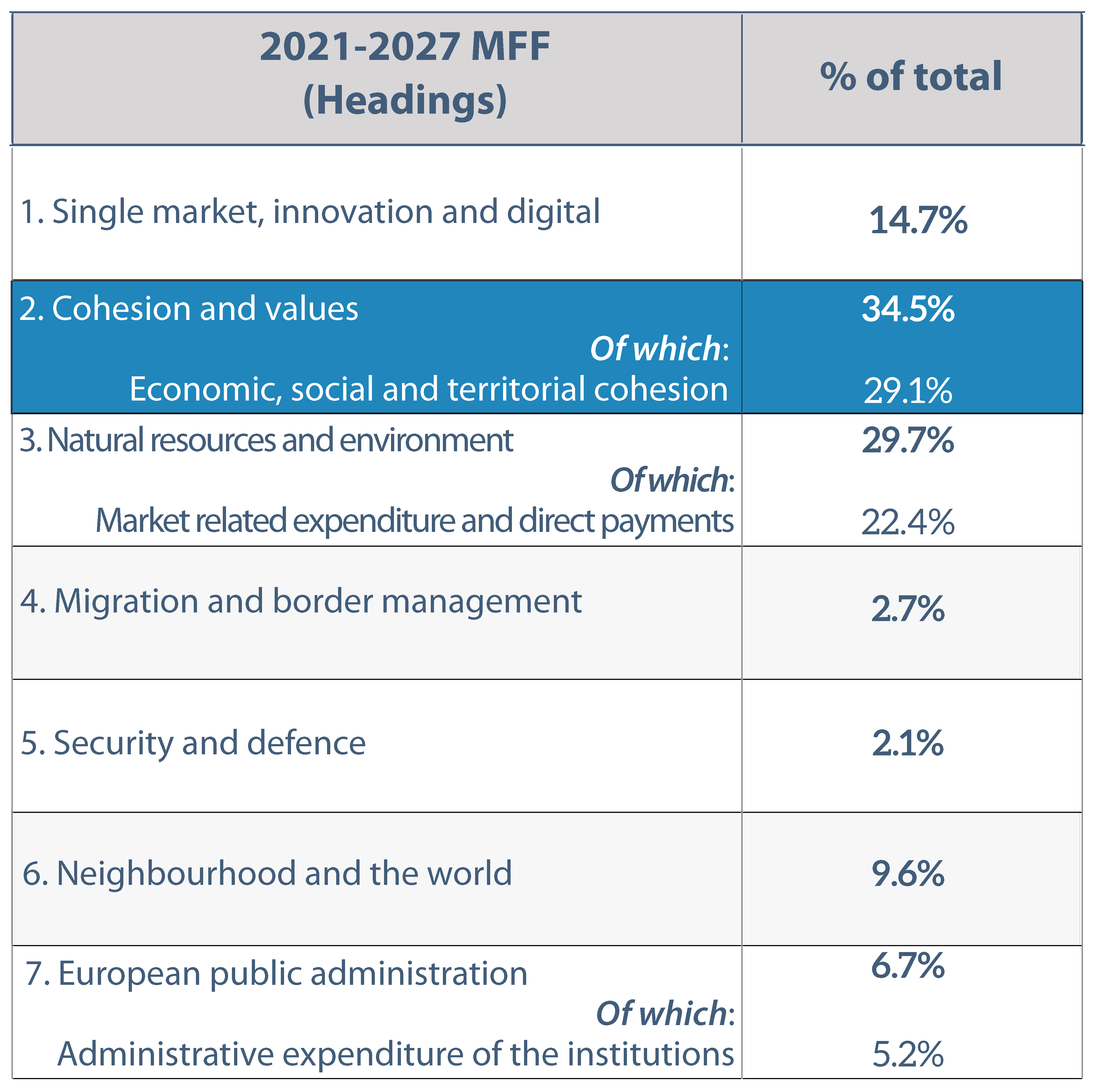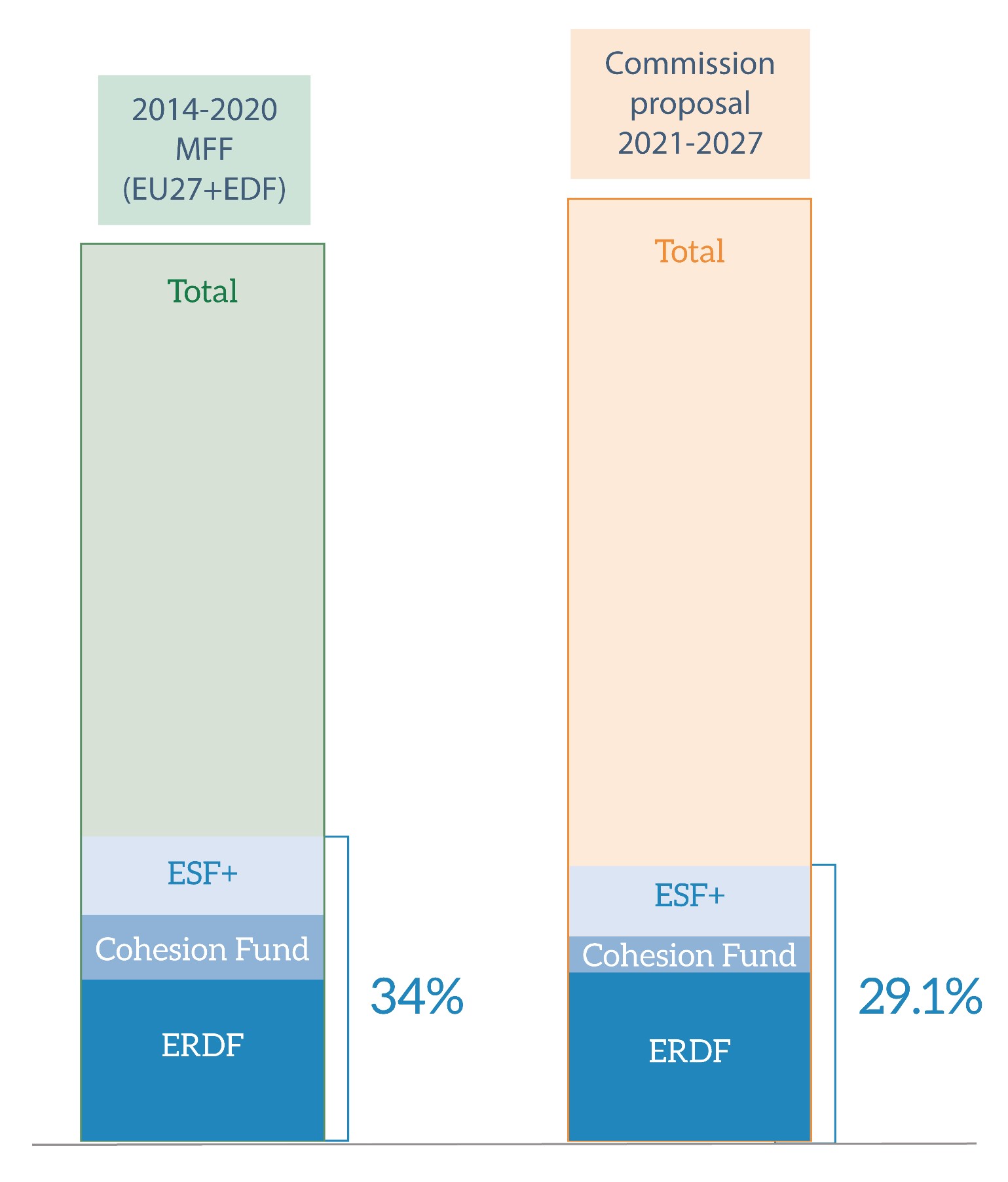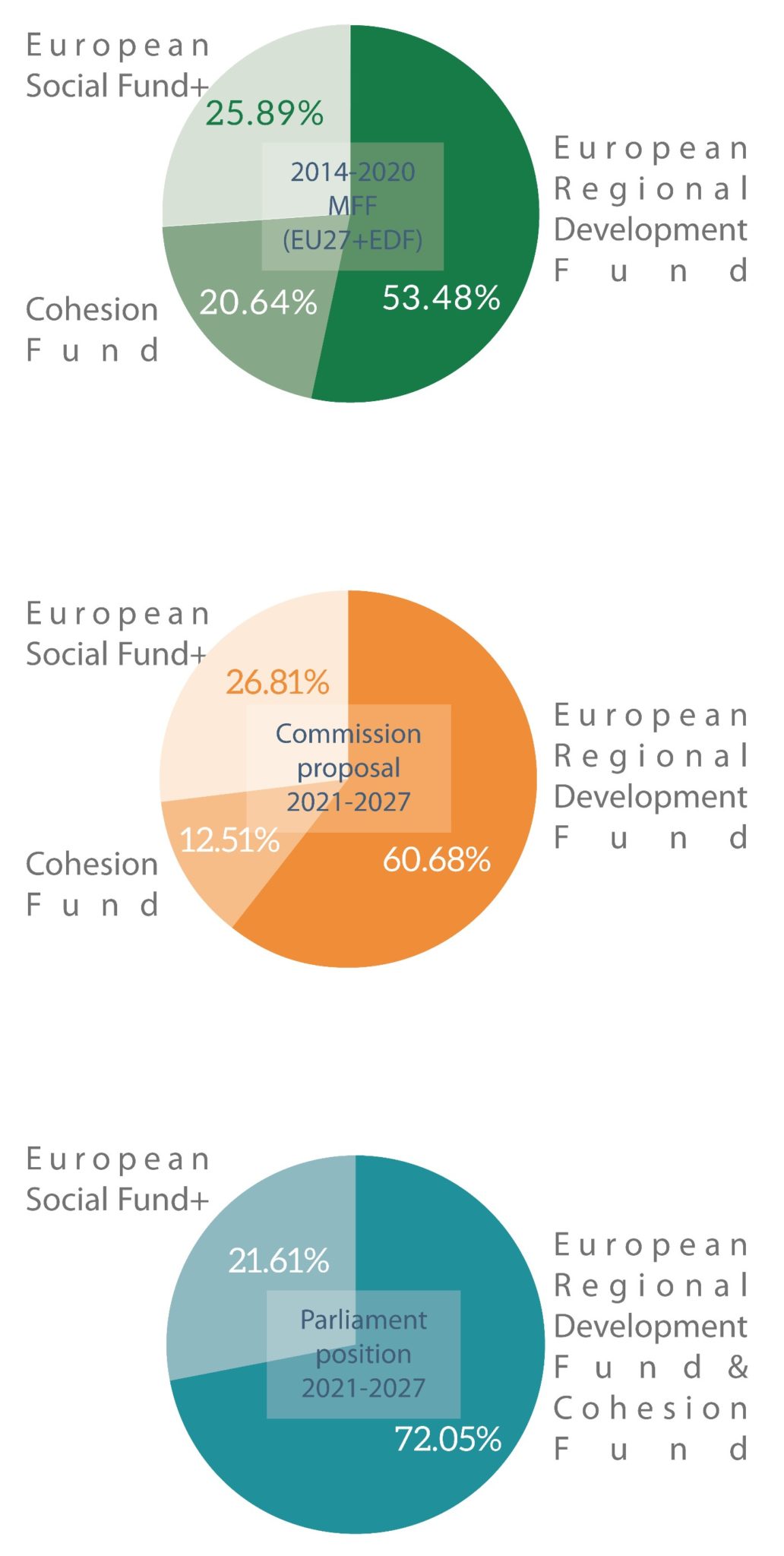How much for Cohesion Policy in the 2021-2027 Multiannual Financial Framework?

DOI reference: 10.1080/13673882.2018.00001042
By Magdalena Sapała (European Parliamentary Research Service)
This article is partly based on Magdalena Sapala (2019) Cohesion funds, values and economic and monetary union in the 2021-2027 MFF, European Parliament, EPRS.
Each year, the size of the EU budget is negotiated within the limits set out in the seven-year financial plan, giving a vision of the EU’s long‑term priorities and known as the multiannual financial framework (MFF). With the MFF for the 2014‑2020 entering its final phase, the preparation of the next MFF is already under way. The MFF package tabled by the European Commission (also as Commission) in May and June 2018 includes proposals on spending priorities for the period 2021-2027 and on rules for implementation of new and continued spending programmes and funds under the next MFF.
The Commission has proposed a 2021-2027 MFF totalling €1 134 583 million (in commitments, 2018 prices). Slightly less than a third of the sum (€330 642 million) has been ring-fenced under a sub-ceiling ‘Economic, social and territorial cohesion’ (see Table 1; for a detailed analysis of the proposal for the 2021-2027, see M. Parry, M. Sapala, 2021-2027 multiannual financial framework and new own resources. Analysis of the Commission’s proposal, EPRS, European Parliament, July 2018.).
This item, equivalent to sub-heading 1b in the 2014-2020 MFF, is often referred to as a budget for cohesion policy (see Table 2). It includes the European Regional Development Fund (ERDF), the Cohesion Fund (including a transfer of €10 000 million to the Connecting Europe Facility), and the shared management strand of European Social Fund+ (i.e. excluding €1 042 million on Health Programme and Social Innovation Programme which are managed directly by the Commission). All prices in this analysis are constant (2018) and all comparisons between 2014 to 2020 figures and proposed 2021 to 2027 figures are based on estimations excluding the UK and including the European Development Fund. For other assumptions for calculations see: M. Parry and M. Sapala, 2021-2027 multiannual financial framework and new own resources. Analysis of the Commission’s proposal, EPRS, European Parliament, 2018.
Although, according to the proposal, the cohesion budget has been cut by 10 % in real terms, and as a share of the total next MFF by 5 %, it would remain, next to the Common Agricultural Policy, the biggest spending category in the MFF (Figure 1). This reduction is, nevertheless, one important demonstration of the shift in priorities of the MFF from traditional to new policies.
Table 1. Proposal for the 2021-2027 MFF. Source: EPRS, based on the European Parliament resolution of 14 November 2018.

Table 2. Allocation for ‘Economic, social and territorial cohesion’ in the 2014-2020 MFF and in the proposal for the 2020-2021 MFF. * Estimations excluding the UK and including the European Development Fund. Source: EPRS, based on European Parliament resolution of 14 November 2018.
| Sub-ceiling ‘Economic, social and territorial cohesion’ | 2014-2020 (EU27+EDF)* | Commission proposal 2021-2027 | Parliament position 2021-2027 |
| Total | 367 553 | 330 642 | 378 097 |
| European Regional Development Fund | 196 564 | 200 622 | 272 411 |
| Cohesion Fund (incl. transfer to CEF) | 75 848 | 41 374 | |
| European Social Fund+ | 96 216 | 89 688 | 106 781 |
| of which health, employment and social innovation | 1 075 | 1 042 | 1 095 |

Figure 1. Share of the cohesion funds in the 2014-2020 MFF and the proposal for the 2021-2027 MFF. Source: EPRS, based on the European Parliament resolution of 14 November 2018.
Each fund would be affected differently by this change – while the ERDF would increase slightly, the ESF+ and the Cohesion Fund would decrease. The most dramatic cut would hit the Cohesion Fund, with its overall allocation decreasing by 45 %. Furthermore, as in the current MFF, the Commission would like to ring-fence almost a quarter of the fund (€10 billion) for transport projects under the directly managed Connecting Europe Facility.
During one of the debates in the European Parliament, the Commission representative justified the cut to the Cohesion Fund by the fact that, since EU enlargement in 2004, its goals have, to a certain extent, been achieved and investment needs have shifted from environmental and transport infrastructure to areas covered by the other programmes and funds, such as research, innovation, education and renewable energy. Therefore, with this reduction the Commission is restoring the previously ‘artificially inflated’ Cohesion Fund allocation to a ‘normal’ level.
One of the innovations introduced by the Commission in the proposal for the next MFF is to merge under the new European Social Fund+ five components. Three of them are managed jointly by the Member States and the Commission (shared management) as part of the budget for cohesion policy and amount to €88 646 million: the existing ESF (investments in employment, education and social inclusion), the Youth Employment Initiative, and the Fund for European Aid to the most deprived. Two other components are managed directly by the European Commission and amount to €1 042 million: the Employment and Social Innovation Programme, and the Health Programme. Despite enlarging the scope, as compared with the current MFF, the ESF+ would shrink by 7 % and amount to €89 688 million.
Given these changes, the relative role of each fund in the budget for cohesion policy would also change: The ERDF would increase its share by 7 % and the Cohesion Fund would decrease by 8 %. The role of the ESF+ would remain almost the same (see Figure 2).
How these figures will translate into the individual Member States’ allocations depends on a complicated set of rules, such as eligibility criteria and region definitions (less developed, transition and more developed), thematic concentration criteria, maximum and minimum levels of transfers from the funds (known as capping and safety nets), and co-financing rates. Documents from the European Commission give some indication of changes in the national envelopes. In comparison with the current MFF, the countries most affected would be Malta (- 28 %), Poland (- 24 %), Hungary and Slovakia (- 22 %). The countries that would benefit from the changes include Romania (17 %), Bulgaria (15 %) and Greece (12 %).
The cuts proposed to cohesion budget were criticised by the European Parliament. In its negotiating position on the future MFF adopted in November 2018, the Parliament demanded that the budget for sub-ceiling ‘Economic, social and territorial cohesion’ should be maintained at least the level of current MFF (in real terms), allocating €378 097 million (14 % more than the Commission’s proposal). This amount includes €272 411 million for the ERDF and Cohesion Fund (without indicating individual sums for the funds and without indicating the amount to be transferred from the Cohesion Fund to CEF-Transport), and €106 781 million for the European Social Fund+.
The Parliament’s view in this regard is shared by the European Committee of the Regions and the European Economic and Social Committee, and also by many other stakeholders organised under the umbrella of the #CohesionAlliance. Although some reduction in the budget for cohesion policy was anticipated, the size of the cut actually proposed was surprising for stakeholders, who called the proposal worrying and disappointing, and feared it would undermine cohesion in Europe over the next decade.
A similar view has already been expressed by the Member States that would be affected by cuts (see above), with the countries declaring – sometimes strong – support for a reduction in the cohesion budget being net contributors to the EU budget, including Austria, Denmark, Finland, the Netherlands and Sweden.

Figure 2. Share of the ERDF, ESF+ and Cohesion Fund in the sub-ceiling Economic, social and territorial cohesion: 2014-2020 MFF, Commission proposal for 2021-2027 MFF and Parliament’s position. Source: EPRS, based on the European Parliament resolution of 14 November 2018.
Apart from the proposed cuts and increases, the other issue with potential budgetary consequences for cohesion policy is a strengthened link between the policy and new instruments for economic and monetary union. Reform support programme (RSP) builds on the existing structural reform support programme, which since its creation in 2017, has been financed by transfers from the cohesion funds. However, its budget and the scope of operation, as well as the link with cohesion policy, is extended significantly as compared with its predecessor. It is designed to support national-level structural reforms that are important for the convergence and resilience of EU Member State economies, and were identified in the country-specific recommendations (including those outside the euro area).
The reforms can cover various policy areas, such as public financial and asset management, institutional and administrative capacities, service and labour markets, the business environment, education and training, public health and education. Moreover, the budget proposed for the RSP (€22.2 billion over seven years) is a hundred times bigger than the allocation for the current structural reform support programme. If compared with some other important EU programmes and funds, this allocation is not modest. It is approximately half of what the Commission has proposed for the Cohesion Fund, almost as much as the budget for Erasmus+ and four and half times more than the LIFE programme for environment and climate action.
Placed together with the cohesion funds in the structure of the MFF (heading 2), the RSP is also seen by the Commission as complementary to the cohesion funds and seen as a way to strengthen links between the cohesion policy framework and the European Semester cycle. Enhancing cohesion is one of the general objectives of the programme. In addition, EU Member States would be able to request the transfer of up to 5 % of resources from allocations of the ERDF, the ESF+, the Cohesion Fund or the European Maritime and Fisheries Fund to the programme.
While the European Parliament agreed with the Commission’s budgetary proposal for the RSP, it did not adopt a position on the objectives of the programme, modalities for its implementation and the link with cohesion policy. The issue sparkled lively discussions at the joint meetings of the Committees on Budgets and on Economic and Monetary Affairs, which were preparing a report on the proposal. Work on this field is now continuing following the recent European elections.
Spending on cohesion policy is an important part of the EU’s long-term budget and of the negotiations on the MFF package. Since May 2018, both the European Parliament and the Council have been examining the Commission’s proposals. As far as the budget and the rules for cohesion policy are concerned, the Parliament has already adopted its position and is ready for the negotiations. However, the progress of the discussions between the Member States has not been sufficient to take decisions before the elections in May 2019. A swift and timely agreement on the future MFF is important for the spending programmes under cohesion policy, in particular for the ERDF, the Cohesion Fund and ESF+. Given the time required for programming at EU, national and regional levels, adoption of the MFF has practical consequences for the smooth start of implementation stage. Late adoption of the 2014-2020 MFF had a major impact with delays implementing present spending programmes.
About the author
Magdalena Sapała is an expert on the EU budget in the European Parliamentary Research Service, a think-tank of the European Parliament in Brussels. She is an author of EPRS papers on performance-based budgeting, the Multiannual Financial Framework and a co-author of the annual Economic and Budgetary Outlook. You can follow her on twitter @SapalaMagdalena